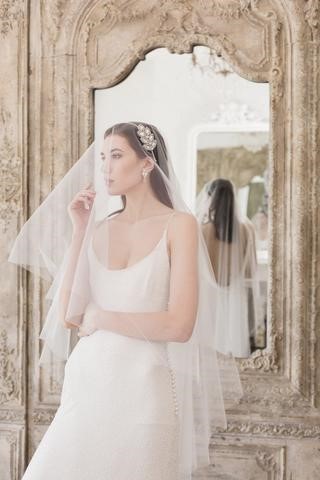How to Choose the Right Wedding Veil
How to Choose the Right Wedding Veil
On your special day you want every aspect of your outfit to be just perfect – from your wedding veil right down to your shoes.
Here we will focus on the wedding veil - a key part of your bridal outfit as it shapes your outfit and frames your face during the ceremony.
The veil was traditionally worn to help guard the bride against evil spirits, as well as to give the bride additional modesty before she is given away be her father during the ceremony. However, these days it is a way of blending tradition and fashion, which is why it is so important to choose the right one!
How long should the veil be?
The veil length is a key consideration for anyone choosing a veil: do you want it simple and short or long and flowing?
Modern dresses are well suited to shorter veils that cover the face or to the shoulders, with elbow and waist length veils being better suited to more formal wedding dresses. The full-length chapel and cathedral length veils are (as the name suggests!) best suited to large church weddings with a wide aisle.
Width
When choosing a wedding veil, you can traditionally choose from three different widths. The thinnest one would be 137cm. It is designed for a sleek look and allows the bride to show off additional details of the wedding dress like elegant sleeves or decorative straps.
If a bride chooses a 274cm wide veil, then it offers a coverage over the arms and shoulders. It looks best with strapless dresses. 182cm wide veils are known as mid-thickness veils. This size works as a medium between the other two. A veil of this size would cover the arms, but at the same time it would still show some details of the dress.
Number of Tiers
Traditionally, veils can be created up to three tiers. The choice depends upon the style of the dress, for example, a one tier veil will have a suave and sophisticated look, but more than two tier veils tend to work better with classic and traditional dresses.
When more than one tier veil is used, then traditionally one of the layers serves as a ‘blusher’, which covers the bride’s face during the ceremony, and the groom lifts it off once their vows are completed and the couple is ready for their first kiss as husband and wife.
What Colour Should it Be?
Most brides would traditionally choose a veil that is in the same colour as their dress, such as, white, off white or ivory. But now more and more brides are choosing slightly different shades and colours, these would still be paired well with the dress, but they would offer a slight contrast highlighting the best features of both the veil and the dress.
Some examples of colours for the veils are blush, champagne and grey/blue, which can all work really well, and allow the bride to stand out.
The bride can also choose between two types of finishes - regular and crystal.
A traditional matt finish can be seen on regular finishes. It is important to have samples of colour to pair them with the dress before choosing to buy anything, because it is not always possible to tell the exact colour and shade from pictures.
A crystal finish gives the veil a shimmering effect and brings additional glamour to your outfit.
Generally, brides will choose to have their veil the same colour as their dress, however a more modern twist is to choose a slightly different shade or colour to bring out the colour or design.
How Many Tiers?
You can choose a veil with up to three tiers, with the choice coming down to the type of dress. A one tier veil is more suited to sleek, modern dresses with two or multi-tier veils better-suited to traditional-style dresses.
The two or multi-tier veils will usually contain a ‘blusher’ which goes over the bride’s face during the ceremony and is lifted off by the groom before the ceremonial first kiss.
Would you like any added decoration?
There are many added layers of decoration and sophistication that can be added to a bridal veil. Adding an elaborate trim with a different material or beautiful floral pattern can help accentuate the dress and bring the entire outfit to life.
More traditional, structured dresses are complemented by decorative veil edges, whereas sleek dresses suit a simple cut edge. You may also want to match a pattern from your dress on the wedding veil, but it is best sampled next to the wedding dress before buying!
Trying a number of wedding veils is important, so visiting a bridal boutique once you have decided on your dress is always a good option. Many suppliers also provide samples of the veil material and pattern so you can compare it without buying the entire veil.







